Erlend Helling-Larsen: The intimacy of embroidery
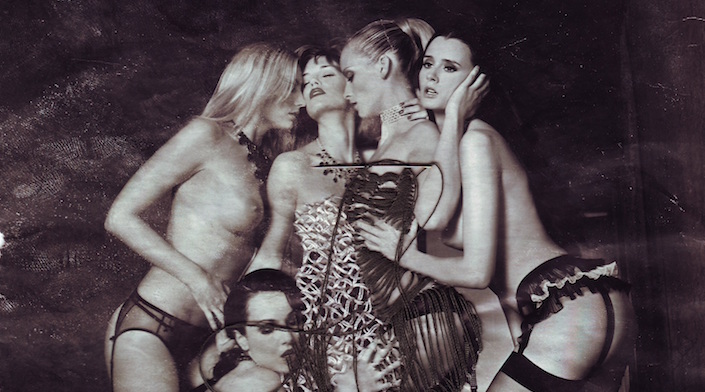
Embroidery is one of the many media Norwegian artist Erlend Helling-Larsen uses. On pages torn from magazines such as Playboy and Penthouse, he clothes the naked women stitch by stitch. His work with embroidery has strong historical references. Contrasts abound in Helling-Larsen’s works, between the masculine and feminine, and between popular culture, handicraft and artistic production.
Erlend studied Psychology and Religion, then went to study art at the Oslo Tegne- og Maleskole , followed by the Gerrit Rietveld Academie in Amsterdam.
After graduating he worked as an assistant for Joshua Neustein in New York.
In this interview Erlend tells us why and when he began to use textile as his medium.
TextileArtist.org: What initially attracted you to textiles as a medium?
Erlend Helling Larsen: I will start with the sad fact that I was never that interested in textile and the use of this in art during my time at the Gerrit Rietveld Academie in Amsterdam. Ten years later, I have reached the conclusion that I am an artist who uses textile as a medium. Maybe this conclusion makes me a textile artist.
It is difficult to tell why and when I did start making embroidery on pages from Playboy. Usually I start my answer with a story. A story about an ill-tempered man, a late night or early morning, outside my kitchen-window in the city center of Amsterdam. He attacked an advertisement for rather minimalistic underwear. He threw rocks at the girl in the advertisement. As the cobblestones hit the girl in the photo, one after another, there was a lot of noise but no visible effect. Even more frustrated, the man started scratching and tearing off pieces of the girl’s naked skin with his bare hands. This action made the posters underneath the advertisement visible and the result was something that looked like a rather colorful dress. I remember this, but I did not start my work concerning nudity and embroidery at this point.
I like the intimacy of embroidery
I probably started this several years later. I had a vague idea about putting dresses on the nude models in Playboy or maybe doing something with porn, as every other serious artist would do. I did make some dresses, using ballpoints and black markers. I wanted something more aesthetically than the censorship by adding black squares or stars in early days. I believed a dress might be a good solution. Like so many other ideas and sketches, these also spent many days on the shelf of things that do not really work as well as they should. One day I looked at them again, and decided it might be worth it to try once more, but with a different approach. This time I would try covering the nude girls with a decent layer of embroidery.
And, more specifically, how was your imagination captured by stitch?
I am not sure I understand this question correctly, but I will anyhow use it to point out a rather obvious but important fact, concerning my choice of material. The material I use is the same as which clothing or textiles are made of, there is just a difference in amount and scale, I like to touch my work. I like the intimacy of embroidery. It is not just added on top of the paper, but goes straight through to the other side. My embroidery is always razor sharp, in contrast to the photos, which are often soft in focus and with layers of Adobe Photoshop.
The craftsmanship needs to be as perfect as possible
How would you describe your work and where do you think it fits within the sphere of contemporary art?
My work started as a small project or an experiment. In the beginning, I did not consider it as textile art but most certainly as contemporary art. In the process of making the project as clear and precise as possible, it turned out it was necessary to use embroidery.
Therefore, I started practicing my embroidery skills starting at zero. It is important to me that the craftsmanship is as perfect as possible, since it is part of both the process and the result. Without the skills in needlework it would just be an illustration of a rather simple and stupid idea.
Do you use a sketchbook? If not, what preparatory work do you do?
I do have a sketchbook, but this book mostly concerns my other work. For embroidery on Playmates I have more like a file or collection of unfinished work, containing my favorite models/pictures and some of my needlework. Sometimes I will look through them, maybe even finish one, or pick out a nice detail for a new piece, and things like that. Even if the intention and the starting point is all good, they are stuck somewhere along the way, and are left in this file for a while.
A few well placed stitches can be as cheeky as a whole dress
Tell us about your process from conception to conclusion.
It was not the long legs, the seductive looks, the naked flesh or the narrow strips of pubic hair that I found unsettling. It was the sewn items I couldn’t handle. I had big plans and good intentions. Combining men’s dream worlds with needlework, something which, back then, I imagined was a decent, harmless women’s occupation. I have embroidered slowly and patiently. I have embellished firm breasts with flowers, stitched curvaceous behinds, and where sex organs are visible, they are not in motion, but sewn firmly in place. I have counted squares, copied grandma’s roses and thought that good ideas deserve good craftsmanship. I have learned that a few well placed stitches can be as cheeky as a whole dress. I make embroidery on paper. That is all there is to it.
I have been doing this for ten years, and there is still no conclusion. Every new type of stitch or new technique gives new possibilities and also changes the conclusion. As a starting point I wanted to be the most decent male artist on the planet. Lately I put more focus on the embroidery and the erotic aspects of my work. When I first started working on this project, I used embroidery as a tool to make nude photos decent. In my recent work the nude models appear rather decent and the embroidery makes it more erotic and sometimes filthy. I think this development is parallel with improving skills and my growing interest in embroidery. Lately I do believe the borders between embroidery and bondage might also just be a question concerning scale and size.
What environment do you like to work in?
My embroidery project is very practical in that sense. It does require my full attention, but also has some of the benefits of small scale needlework, and can easily join me on holidays and so on. I do not always need my studio but a Playboy magazine and a small embroidery-kit will do just fine for a week or so.
Just one stitch can be the starting point for the next piece
What currently inspires you?
I do not put too much trust in inspiration. Usually my own process is the inspiration. While working (stitching is rather time-consuming) new ideas for the next piece are developed. A small detail (maybe just one stitch) that works or does not work at all can be the starting point for the next piece. In addition, part of the drive or progress comes from learning the craft of embroidery, as new skills and knowledge give me possibilities I was unaware of before.
Recently I also bought an embroidery machine. I have been working on trying to make a limited edition in a small number of five or so. I bought ten copies of the same Playboy issue, and started making drawings on the computer this time. The machine then sews this drawing onto the Playmates and can be repeated as many times as necessary. Doing this by machine instead of by hand, changes the process and the result completely. It is in these kind of situations I do find my inspiration, the possibilities and limitations that naturally come from the medium itself.
Who have been your major influences and why?
I remember seeing some of Ghada Amer‘s work when I was still living in Amsterdam. I think this made me consider the possibility of using embroidery as a technique later when I needed it.
Others of great and more general influence would be artists like Jaspher Johns, Robert Ryman, Jan Groth, Bas Jan Ader, Giuseppe Penone and I would also have to mention the Zero-groep. What they all have in common is a certain kind of simplicity. I still search for a starting point as simple as possible, as things tend to get complicated along the way.
Tell us about a piece of your work that holds particularly fond memories and why?
Some of the early embroidery pieces I did have a quality I did not recognize at the time. I can remember the frustration when working on them, recognizing the potential in the combination of nude skin on glossy paper and embroidery, but not really having the skills to do so. They are recognizable as attempts of embroidery, but look like thread applied to paper. They are far from elegant, but very expressive in a rather brutal and clumsy way.
What advice would you give to an aspiring textile artist?
Do not narrow everything down to textile but look for the quality possibilities; or the strong or specific trait of textile, what distinguishes textile from drawing or painting, video or writing.
The core of what all art is made of
What piece of equipment or tool could you not live without?
I think I could manage without any equipment or specific tools, but I would need a contrast of some kind. That is what I do, I put contrasts next to each other or on top of each other. A black line on a white paper, red paint next to green and so on. I personally think that is the core of what all art is made of. Maybe this is more a trick than a tool, but it is something I could not do without.
Do you give talks or run workshops or classes? If so where can readers find information about these?
I often do workshops in connection with exhibitions showing my Playmates. I provide the participants with my Playboy collection and my embroidery equipment, neatly organized in my grandmother’s traditional large sewing box. The participants are then invited to do as I do. Following a short introduction, they pick a nude model from a Playboy magazine, tear it out and then do their best with needle and thread. I also give some practical tips and tricks along the way.
Usually the atmosphere turns into something similar to a traditional sewing circle, with hours of concentration, but also discussions concerning feminism, embroidery and textile as a female tradition, erotica and of course nudity, porn, the female body as object of desire. But also subjects like embroidery techniques used in the history of art and contemporary art.
The results are surprisingly good, and I often learn a thing or two myself.
How do you go about choosing where to show your work?
Lately, I have regretfully not found the time to apply for many exhibitions and galleries. But I am always very open for suggestions and enjoy seeing my work in new contexts.
Before being invited to take part in a textile art exhibition, I hadn’t not considered myself a textile artist.
Where can readers see your work this year?
I am doing a large-scale installation with painted plexiglas inside a library in my hometown of Lillesand in 2016. I very much look forward to painting again. This installation, if it works out as planned, will have a reference to lace and curtains, but this time done with paint.
As for the Playmates, I am not sure, but they are doing quite well lately and get to travel a lot. I would be more than happy to do an exhibition somewhere in the UK and combine it with a workshop.
There is a nice collection of my embroidery work at gallery Fineart in Oslo.
For more information please visit my website http://www.erlendhellinglarsen.com/
If you’ve enjoyed this interview with Erlend why not share it with your friends on Facebook using the button below?








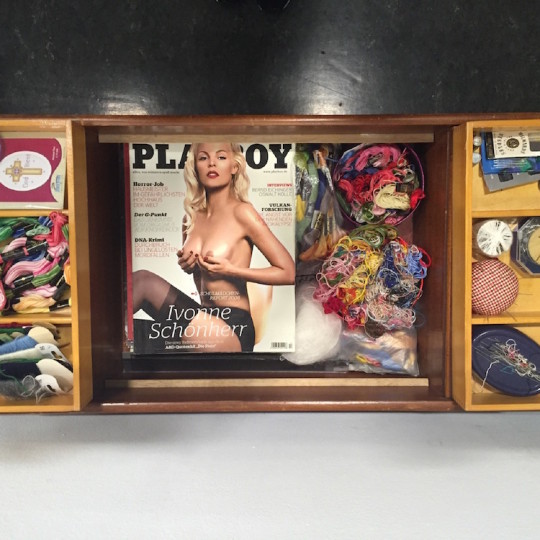
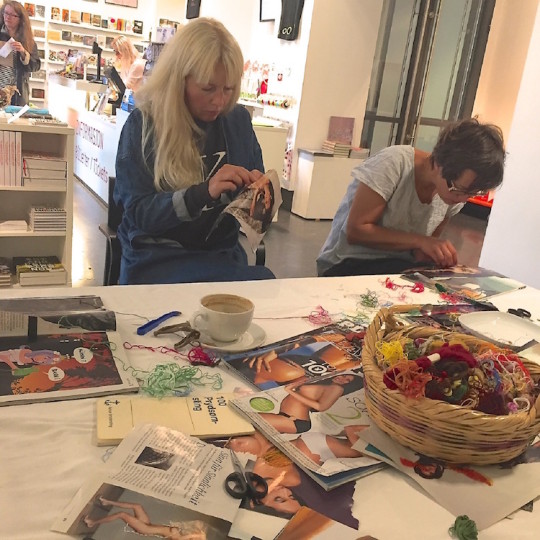
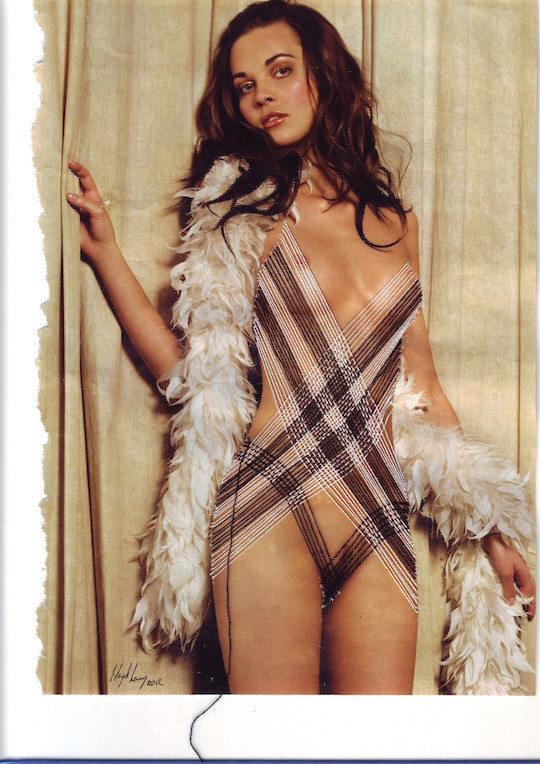
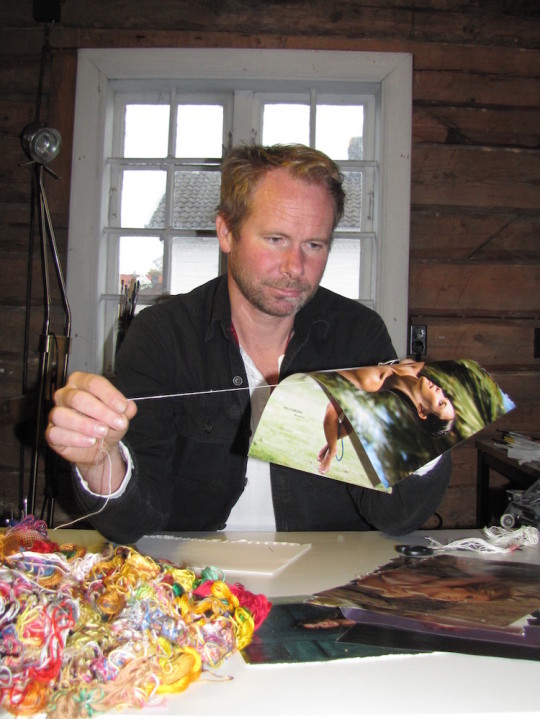















I am fascinated by this embroidery on Playmates! But I have many questions! How does he stabilize the paper to keep it from tearing? Also, they look much larger than regular magazine pages, I know they’re not all centerfold shots! Is he enlarging them and printing them on firmer paper?
Love the new format!
Sorry for a late reply. I do not stabilize the paper. Just handle with care and they will not tear.